Communication Strategies in Health and Social Care Organizations
VerifiedAdded on 2020/07/23
|10
|2360
|31
Report
AI Summary
This report provides a comprehensive analysis of communication within health and social care organizations, focusing on Melba Lodge, a residential home specializing in mental health and learning disabilities. It begins by introducing the importance of effective communication and its impact on patient care. The report then delves into various communication theories, including Humanistic, Cognitive, Social, and Psychoanalytic theories, highlighting their application in healthcare settings. It explores the influence of individual values and cultural factors on the communication process, emphasizing the need for sensitivity to age, sex, and education levels. The report also examines the impact of legislation, charters, and codes of practice on communication, such as the Discrimination Act and confidentiality laws. Furthermore, it discusses the effectiveness of organizational systems and policies in promoting good communication practices. The report concludes by analyzing the impact of legal considerations and the benefits of using Information and Communication Technology (ICT) in health and social care, including improvements for service users, care homes, and healthcare professionals. The report references relevant literature to support its findings.
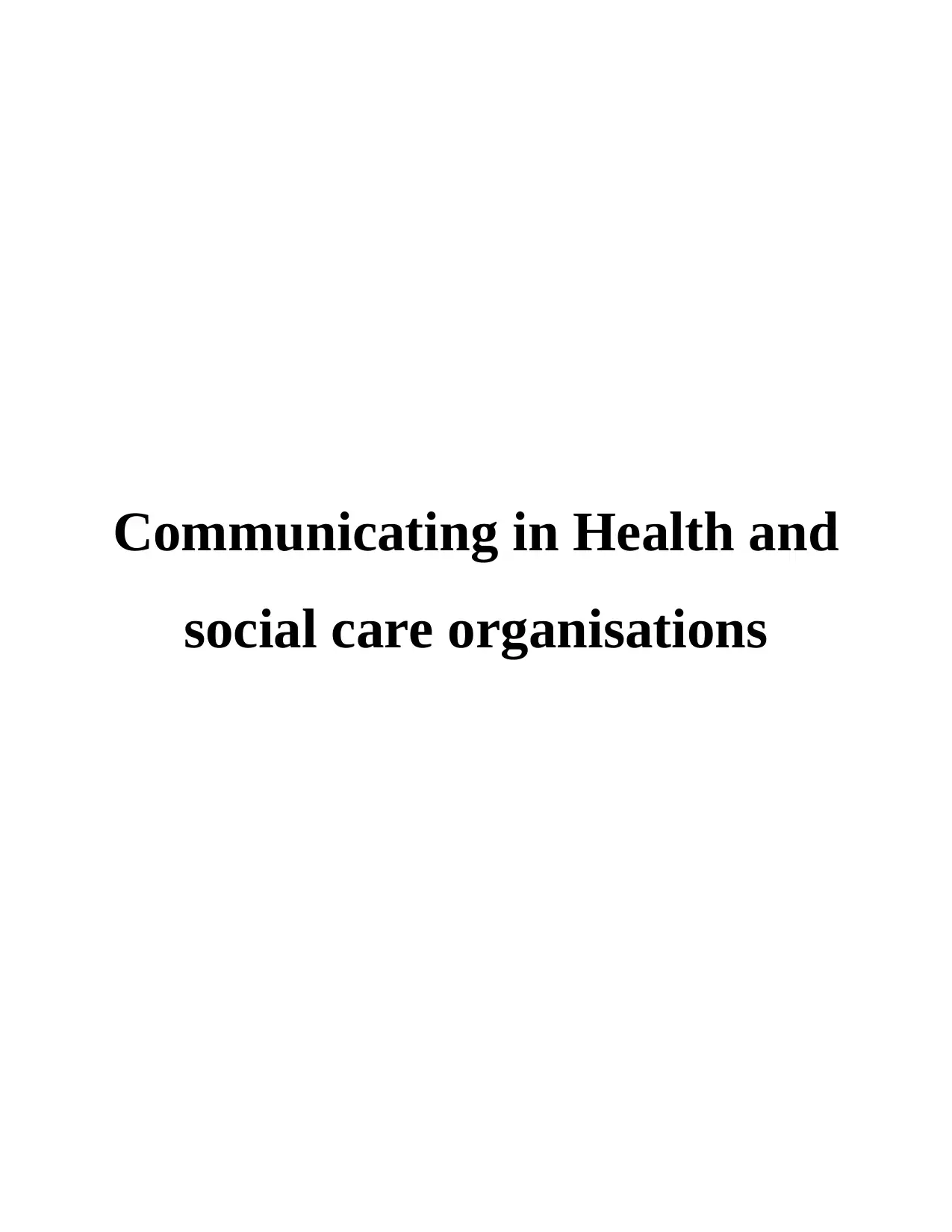
Communicating in Health and
social care organisations
social care organisations
Paraphrase This Document
Need a fresh take? Get an instant paraphrase of this document with our AI Paraphraser
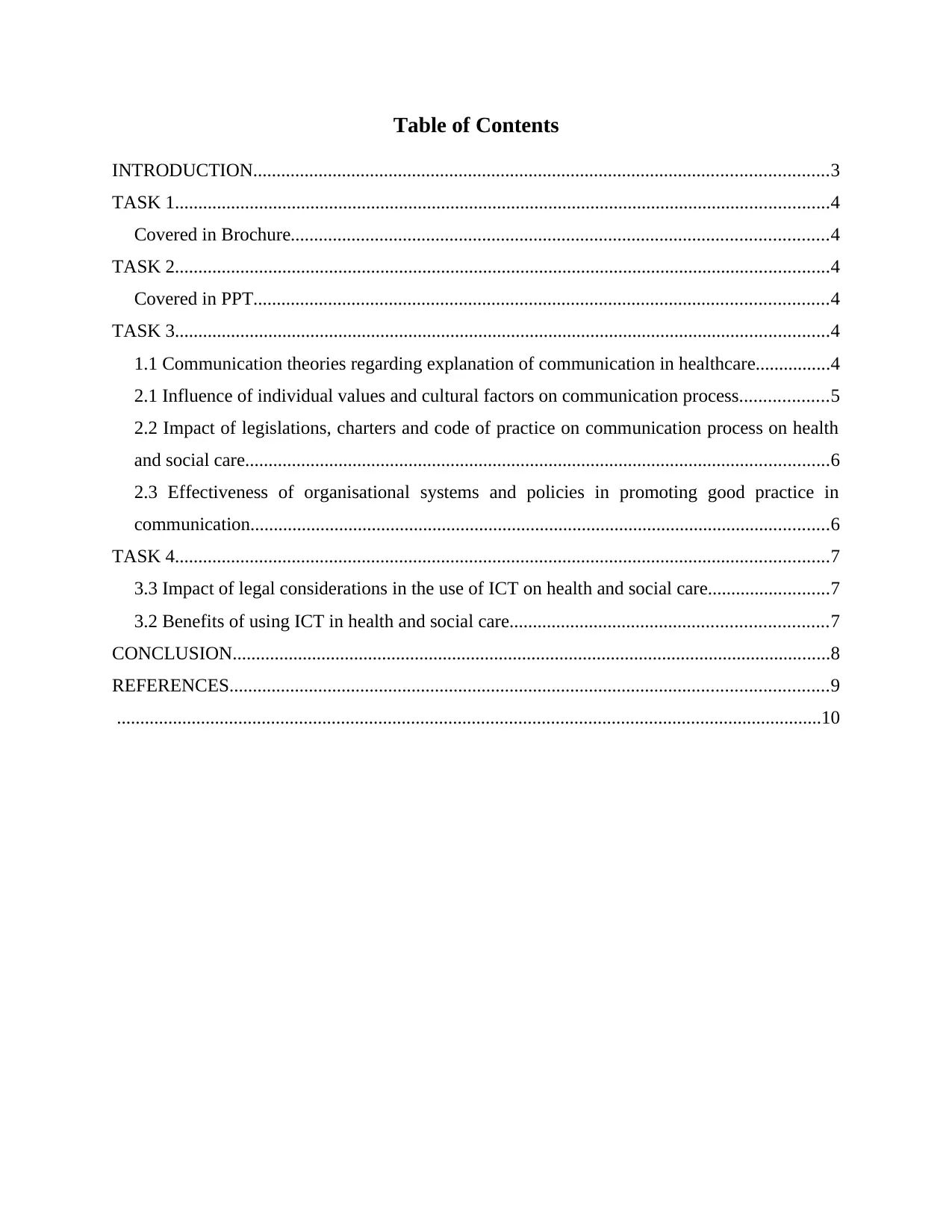
Table of Contents
INTRODUCTION...........................................................................................................................3
TASK 1............................................................................................................................................4
Covered in Brochure...................................................................................................................4
TASK 2............................................................................................................................................4
Covered in PPT...........................................................................................................................4
TASK 3............................................................................................................................................4
1.1 Communication theories regarding explanation of communication in healthcare................4
2.1 Influence of individual values and cultural factors on communication process...................5
2.2 Impact of legislations, charters and code of practice on communication process on health
and social care.............................................................................................................................6
2.3 Effectiveness of organisational systems and policies in promoting good practice in
communication............................................................................................................................6
TASK 4............................................................................................................................................7
3.3 Impact of legal considerations in the use of ICT on health and social care..........................7
3.2 Benefits of using ICT in health and social care....................................................................7
CONCLUSION................................................................................................................................8
REFERENCES................................................................................................................................9
.......................................................................................................................................................10
INTRODUCTION...........................................................................................................................3
TASK 1............................................................................................................................................4
Covered in Brochure...................................................................................................................4
TASK 2............................................................................................................................................4
Covered in PPT...........................................................................................................................4
TASK 3............................................................................................................................................4
1.1 Communication theories regarding explanation of communication in healthcare................4
2.1 Influence of individual values and cultural factors on communication process...................5
2.2 Impact of legislations, charters and code of practice on communication process on health
and social care.............................................................................................................................6
2.3 Effectiveness of organisational systems and policies in promoting good practice in
communication............................................................................................................................6
TASK 4............................................................................................................................................7
3.3 Impact of legal considerations in the use of ICT on health and social care..........................7
3.2 Benefits of using ICT in health and social care....................................................................7
CONCLUSION................................................................................................................................8
REFERENCES................................................................................................................................9
.......................................................................................................................................................10
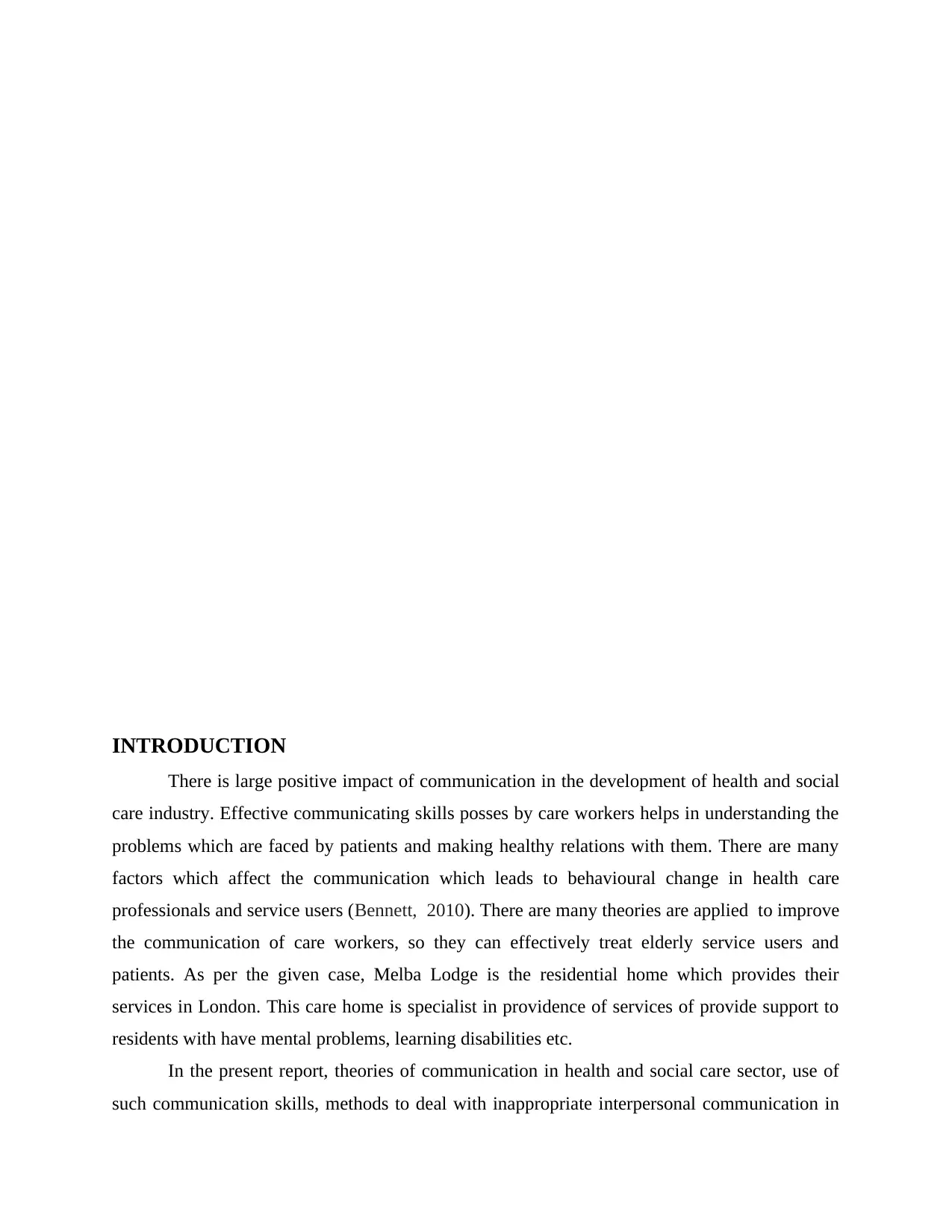
INTRODUCTION
There is large positive impact of communication in the development of health and social
care industry. Effective communicating skills posses by care workers helps in understanding the
problems which are faced by patients and making healthy relations with them. There are many
factors which affect the communication which leads to behavioural change in health care
professionals and service users (Bennett, 2010). There are many theories are applied to improve
the communication of care workers, so they can effectively treat elderly service users and
patients. As per the given case, Melba Lodge is the residential home which provides their
services in London. This care home is specialist in providence of services of provide support to
residents with have mental problems, learning disabilities etc.
In the present report, theories of communication in health and social care sector, use of
such communication skills, methods to deal with inappropriate interpersonal communication in
There is large positive impact of communication in the development of health and social
care industry. Effective communicating skills posses by care workers helps in understanding the
problems which are faced by patients and making healthy relations with them. There are many
factors which affect the communication which leads to behavioural change in health care
professionals and service users (Bennett, 2010). There are many theories are applied to improve
the communication of care workers, so they can effectively treat elderly service users and
patients. As per the given case, Melba Lodge is the residential home which provides their
services in London. This care home is specialist in providence of services of provide support to
residents with have mental problems, learning disabilities etc.
In the present report, theories of communication in health and social care sector, use of
such communication skills, methods to deal with inappropriate interpersonal communication in
⊘ This is a preview!⊘
Do you want full access?
Subscribe today to unlock all pages.

Trusted by 1+ million students worldwide
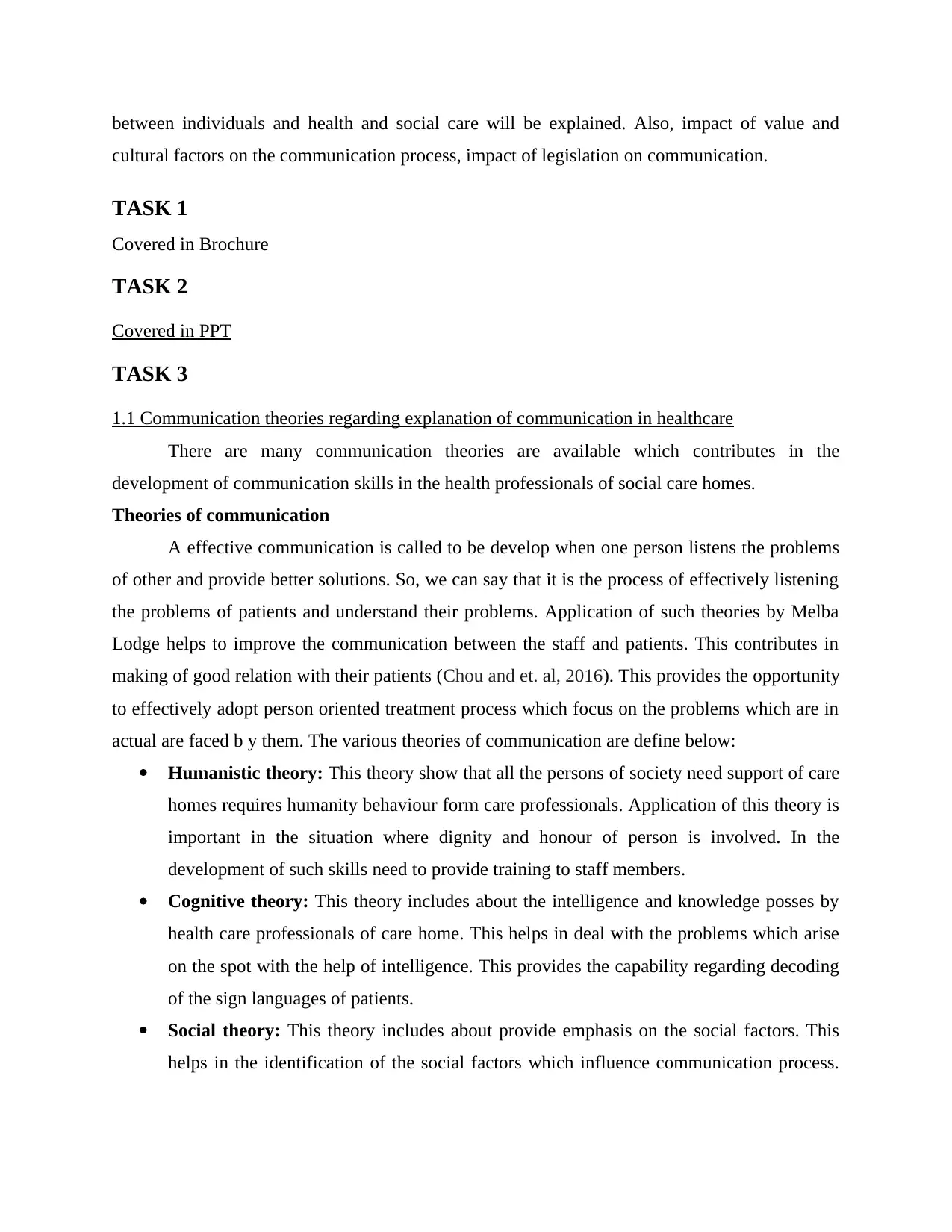
between individuals and health and social care will be explained. Also, impact of value and
cultural factors on the communication process, impact of legislation on communication.
TASK 1
Covered in Brochure
TASK 2
Covered in PPT
TASK 3
1.1 Communication theories regarding explanation of communication in healthcare
There are many communication theories are available which contributes in the
development of communication skills in the health professionals of social care homes.
Theories of communication
A effective communication is called to be develop when one person listens the problems
of other and provide better solutions. So, we can say that it is the process of effectively listening
the problems of patients and understand their problems. Application of such theories by Melba
Lodge helps to improve the communication between the staff and patients. This contributes in
making of good relation with their patients (Chou and et. al, 2016). This provides the opportunity
to effectively adopt person oriented treatment process which focus on the problems which are in
actual are faced b y them. The various theories of communication are define below:
Humanistic theory: This theory show that all the persons of society need support of care
homes requires humanity behaviour form care professionals. Application of this theory is
important in the situation where dignity and honour of person is involved. In the
development of such skills need to provide training to staff members.
Cognitive theory: This theory includes about the intelligence and knowledge posses by
health care professionals of care home. This helps in deal with the problems which arise
on the spot with the help of intelligence. This provides the capability regarding decoding
of the sign languages of patients.
Social theory: This theory includes about provide emphasis on the social factors. This
helps in the identification of the social factors which influence communication process.
cultural factors on the communication process, impact of legislation on communication.
TASK 1
Covered in Brochure
TASK 2
Covered in PPT
TASK 3
1.1 Communication theories regarding explanation of communication in healthcare
There are many communication theories are available which contributes in the
development of communication skills in the health professionals of social care homes.
Theories of communication
A effective communication is called to be develop when one person listens the problems
of other and provide better solutions. So, we can say that it is the process of effectively listening
the problems of patients and understand their problems. Application of such theories by Melba
Lodge helps to improve the communication between the staff and patients. This contributes in
making of good relation with their patients (Chou and et. al, 2016). This provides the opportunity
to effectively adopt person oriented treatment process which focus on the problems which are in
actual are faced b y them. The various theories of communication are define below:
Humanistic theory: This theory show that all the persons of society need support of care
homes requires humanity behaviour form care professionals. Application of this theory is
important in the situation where dignity and honour of person is involved. In the
development of such skills need to provide training to staff members.
Cognitive theory: This theory includes about the intelligence and knowledge posses by
health care professionals of care home. This helps in deal with the problems which arise
on the spot with the help of intelligence. This provides the capability regarding decoding
of the sign languages of patients.
Social theory: This theory includes about provide emphasis on the social factors. This
helps in the identification of the social factors which influence communication process.
Paraphrase This Document
Need a fresh take? Get an instant paraphrase of this document with our AI Paraphraser
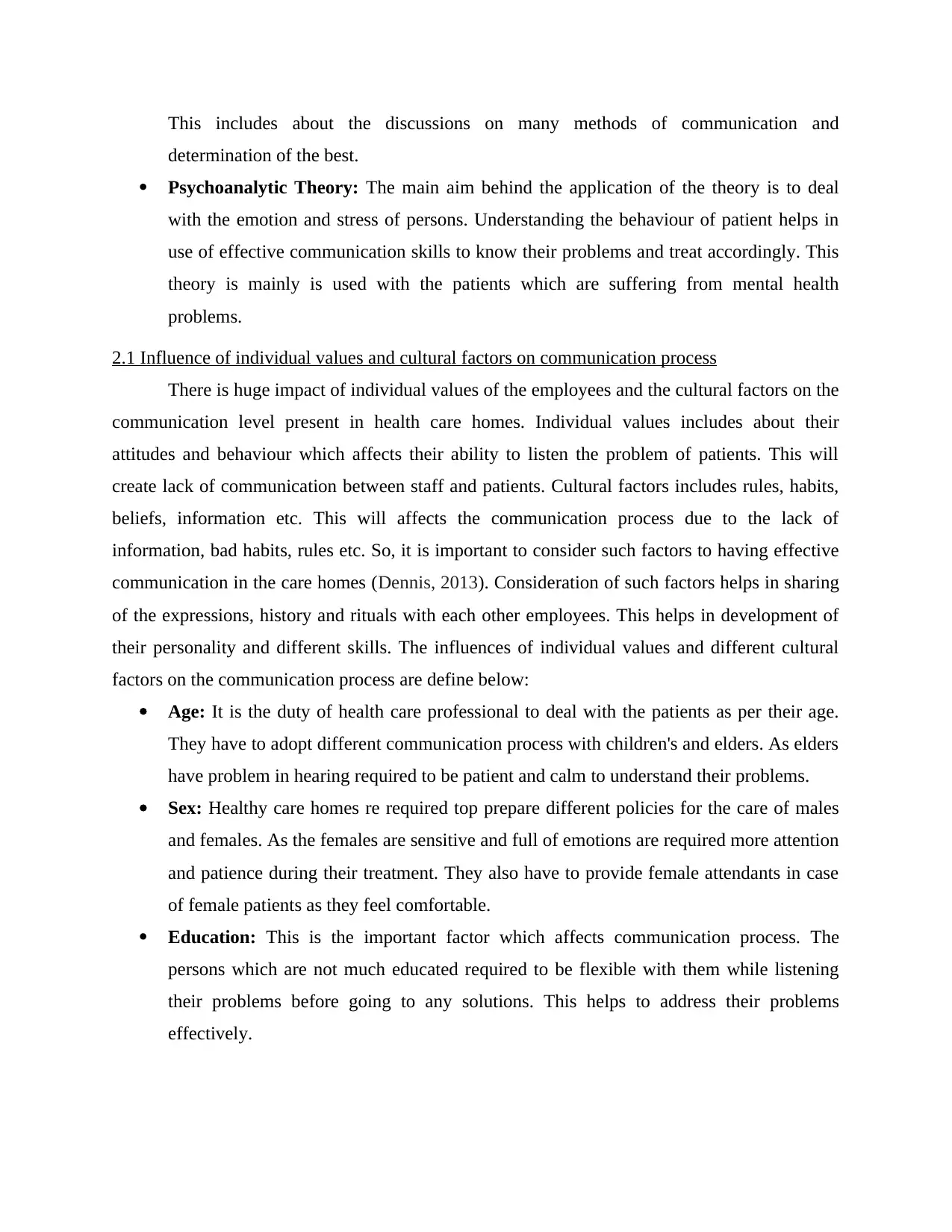
This includes about the discussions on many methods of communication and
determination of the best.
Psychoanalytic Theory: The main aim behind the application of the theory is to deal
with the emotion and stress of persons. Understanding the behaviour of patient helps in
use of effective communication skills to know their problems and treat accordingly. This
theory is mainly is used with the patients which are suffering from mental health
problems.
2.1 Influence of individual values and cultural factors on communication process
There is huge impact of individual values of the employees and the cultural factors on the
communication level present in health care homes. Individual values includes about their
attitudes and behaviour which affects their ability to listen the problem of patients. This will
create lack of communication between staff and patients. Cultural factors includes rules, habits,
beliefs, information etc. This will affects the communication process due to the lack of
information, bad habits, rules etc. So, it is important to consider such factors to having effective
communication in the care homes (Dennis, 2013). Consideration of such factors helps in sharing
of the expressions, history and rituals with each other employees. This helps in development of
their personality and different skills. The influences of individual values and different cultural
factors on the communication process are define below:
Age: It is the duty of health care professional to deal with the patients as per their age.
They have to adopt different communication process with children's and elders. As elders
have problem in hearing required to be patient and calm to understand their problems.
Sex: Healthy care homes re required top prepare different policies for the care of males
and females. As the females are sensitive and full of emotions are required more attention
and patience during their treatment. They also have to provide female attendants in case
of female patients as they feel comfortable.
Education: This is the important factor which affects communication process. The
persons which are not much educated required to be flexible with them while listening
their problems before going to any solutions. This helps to address their problems
effectively.
determination of the best.
Psychoanalytic Theory: The main aim behind the application of the theory is to deal
with the emotion and stress of persons. Understanding the behaviour of patient helps in
use of effective communication skills to know their problems and treat accordingly. This
theory is mainly is used with the patients which are suffering from mental health
problems.
2.1 Influence of individual values and cultural factors on communication process
There is huge impact of individual values of the employees and the cultural factors on the
communication level present in health care homes. Individual values includes about their
attitudes and behaviour which affects their ability to listen the problem of patients. This will
create lack of communication between staff and patients. Cultural factors includes rules, habits,
beliefs, information etc. This will affects the communication process due to the lack of
information, bad habits, rules etc. So, it is important to consider such factors to having effective
communication in the care homes (Dennis, 2013). Consideration of such factors helps in sharing
of the expressions, history and rituals with each other employees. This helps in development of
their personality and different skills. The influences of individual values and different cultural
factors on the communication process are define below:
Age: It is the duty of health care professional to deal with the patients as per their age.
They have to adopt different communication process with children's and elders. As elders
have problem in hearing required to be patient and calm to understand their problems.
Sex: Healthy care homes re required top prepare different policies for the care of males
and females. As the females are sensitive and full of emotions are required more attention
and patience during their treatment. They also have to provide female attendants in case
of female patients as they feel comfortable.
Education: This is the important factor which affects communication process. The
persons which are not much educated required to be flexible with them while listening
their problems before going to any solutions. This helps to address their problems
effectively.
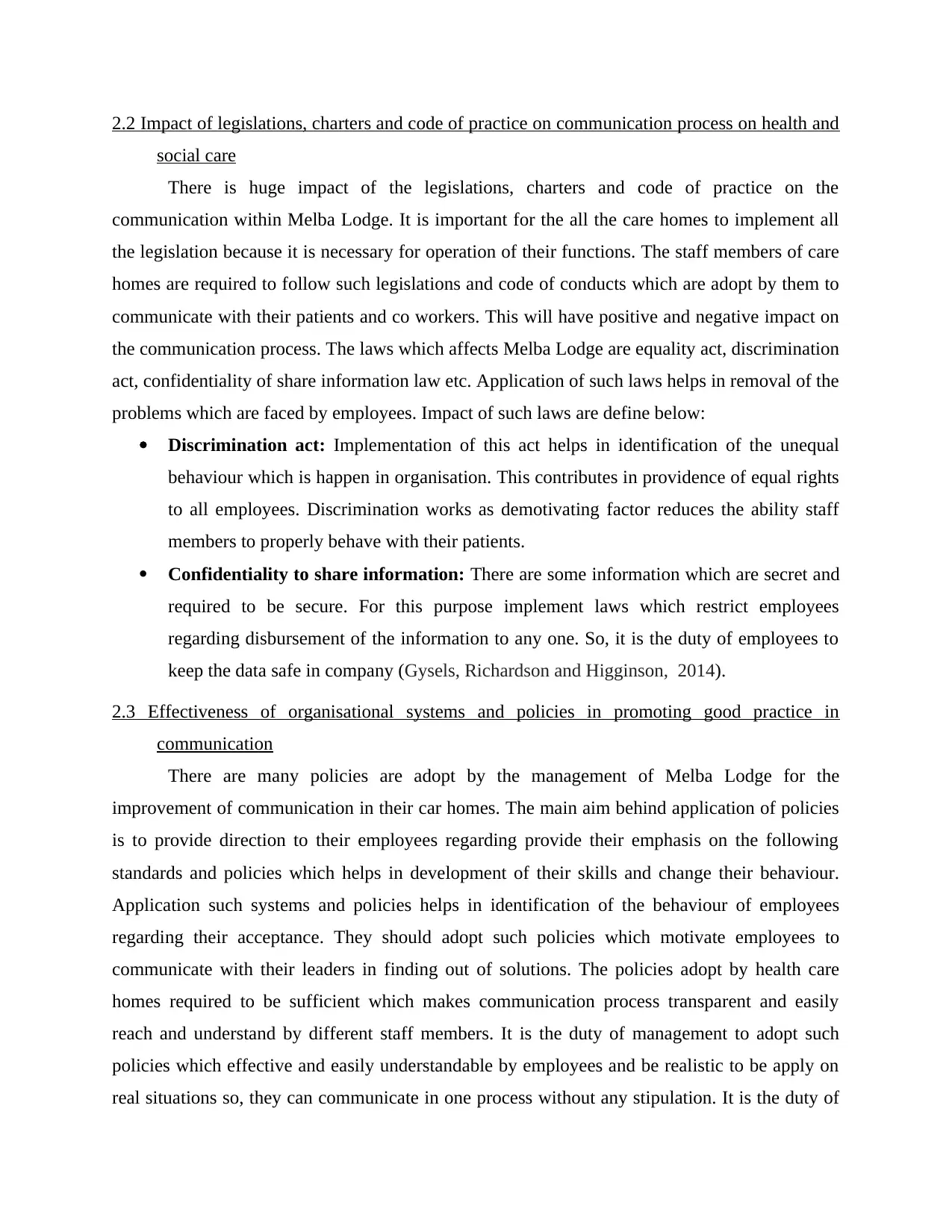
2.2 Impact of legislations, charters and code of practice on communication process on health and
social care
There is huge impact of the legislations, charters and code of practice on the
communication within Melba Lodge. It is important for the all the care homes to implement all
the legislation because it is necessary for operation of their functions. The staff members of care
homes are required to follow such legislations and code of conducts which are adopt by them to
communicate with their patients and co workers. This will have positive and negative impact on
the communication process. The laws which affects Melba Lodge are equality act, discrimination
act, confidentiality of share information law etc. Application of such laws helps in removal of the
problems which are faced by employees. Impact of such laws are define below:
Discrimination act: Implementation of this act helps in identification of the unequal
behaviour which is happen in organisation. This contributes in providence of equal rights
to all employees. Discrimination works as demotivating factor reduces the ability staff
members to properly behave with their patients.
Confidentiality to share information: There are some information which are secret and
required to be secure. For this purpose implement laws which restrict employees
regarding disbursement of the information to any one. So, it is the duty of employees to
keep the data safe in company (Gysels, Richardson and Higginson, 2014).
2.3 Effectiveness of organisational systems and policies in promoting good practice in
communication
There are many policies are adopt by the management of Melba Lodge for the
improvement of communication in their car homes. The main aim behind application of policies
is to provide direction to their employees regarding provide their emphasis on the following
standards and policies which helps in development of their skills and change their behaviour.
Application such systems and policies helps in identification of the behaviour of employees
regarding their acceptance. They should adopt such policies which motivate employees to
communicate with their leaders in finding out of solutions. The policies adopt by health care
homes required to be sufficient which makes communication process transparent and easily
reach and understand by different staff members. It is the duty of management to adopt such
policies which effective and easily understandable by employees and be realistic to be apply on
real situations so, they can communicate in one process without any stipulation. It is the duty of
social care
There is huge impact of the legislations, charters and code of practice on the
communication within Melba Lodge. It is important for the all the care homes to implement all
the legislation because it is necessary for operation of their functions. The staff members of care
homes are required to follow such legislations and code of conducts which are adopt by them to
communicate with their patients and co workers. This will have positive and negative impact on
the communication process. The laws which affects Melba Lodge are equality act, discrimination
act, confidentiality of share information law etc. Application of such laws helps in removal of the
problems which are faced by employees. Impact of such laws are define below:
Discrimination act: Implementation of this act helps in identification of the unequal
behaviour which is happen in organisation. This contributes in providence of equal rights
to all employees. Discrimination works as demotivating factor reduces the ability staff
members to properly behave with their patients.
Confidentiality to share information: There are some information which are secret and
required to be secure. For this purpose implement laws which restrict employees
regarding disbursement of the information to any one. So, it is the duty of employees to
keep the data safe in company (Gysels, Richardson and Higginson, 2014).
2.3 Effectiveness of organisational systems and policies in promoting good practice in
communication
There are many policies are adopt by the management of Melba Lodge for the
improvement of communication in their car homes. The main aim behind application of policies
is to provide direction to their employees regarding provide their emphasis on the following
standards and policies which helps in development of their skills and change their behaviour.
Application such systems and policies helps in identification of the behaviour of employees
regarding their acceptance. They should adopt such policies which motivate employees to
communicate with their leaders in finding out of solutions. The policies adopt by health care
homes required to be sufficient which makes communication process transparent and easily
reach and understand by different staff members. It is the duty of management to adopt such
policies which effective and easily understandable by employees and be realistic to be apply on
real situations so, they can communicate in one process without any stipulation. It is the duty of
⊘ This is a preview!⊘
Do you want full access?
Subscribe today to unlock all pages.

Trusted by 1+ million students worldwide
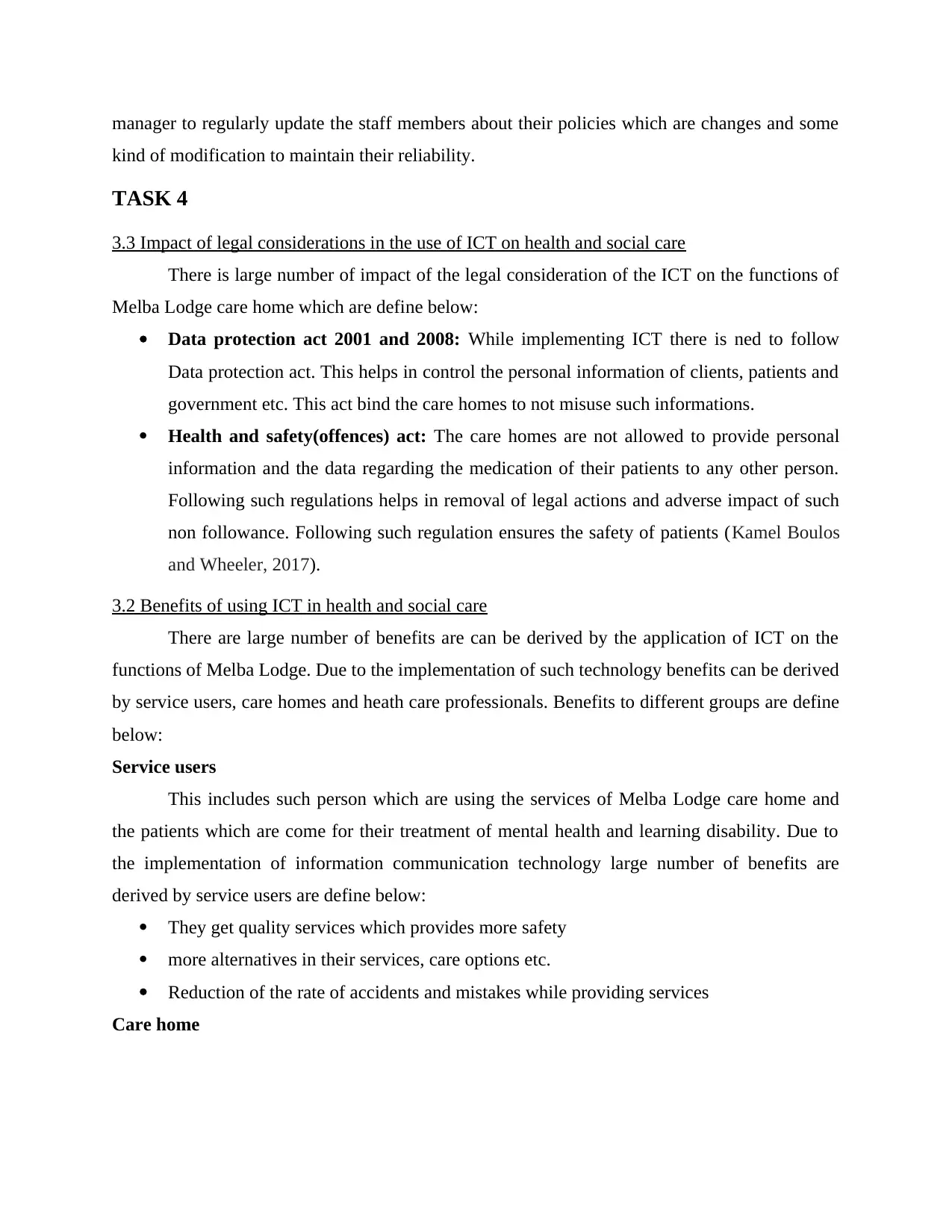
manager to regularly update the staff members about their policies which are changes and some
kind of modification to maintain their reliability.
TASK 4
3.3 Impact of legal considerations in the use of ICT on health and social care
There is large number of impact of the legal consideration of the ICT on the functions of
Melba Lodge care home which are define below:
Data protection act 2001 and 2008: While implementing ICT there is ned to follow
Data protection act. This helps in control the personal information of clients, patients and
government etc. This act bind the care homes to not misuse such informations.
Health and safety(offences) act: The care homes are not allowed to provide personal
information and the data regarding the medication of their patients to any other person.
Following such regulations helps in removal of legal actions and adverse impact of such
non followance. Following such regulation ensures the safety of patients (Kamel Boulos
and Wheeler, 2017).
3.2 Benefits of using ICT in health and social care
There are large number of benefits are can be derived by the application of ICT on the
functions of Melba Lodge. Due to the implementation of such technology benefits can be derived
by service users, care homes and heath care professionals. Benefits to different groups are define
below:
Service users
This includes such person which are using the services of Melba Lodge care home and
the patients which are come for their treatment of mental health and learning disability. Due to
the implementation of information communication technology large number of benefits are
derived by service users are define below:
They get quality services which provides more safety
more alternatives in their services, care options etc.
Reduction of the rate of accidents and mistakes while providing services
Care home
kind of modification to maintain their reliability.
TASK 4
3.3 Impact of legal considerations in the use of ICT on health and social care
There is large number of impact of the legal consideration of the ICT on the functions of
Melba Lodge care home which are define below:
Data protection act 2001 and 2008: While implementing ICT there is ned to follow
Data protection act. This helps in control the personal information of clients, patients and
government etc. This act bind the care homes to not misuse such informations.
Health and safety(offences) act: The care homes are not allowed to provide personal
information and the data regarding the medication of their patients to any other person.
Following such regulations helps in removal of legal actions and adverse impact of such
non followance. Following such regulation ensures the safety of patients (Kamel Boulos
and Wheeler, 2017).
3.2 Benefits of using ICT in health and social care
There are large number of benefits are can be derived by the application of ICT on the
functions of Melba Lodge. Due to the implementation of such technology benefits can be derived
by service users, care homes and heath care professionals. Benefits to different groups are define
below:
Service users
This includes such person which are using the services of Melba Lodge care home and
the patients which are come for their treatment of mental health and learning disability. Due to
the implementation of information communication technology large number of benefits are
derived by service users are define below:
They get quality services which provides more safety
more alternatives in their services, care options etc.
Reduction of the rate of accidents and mistakes while providing services
Care home
Paraphrase This Document
Need a fresh take? Get an instant paraphrase of this document with our AI Paraphraser
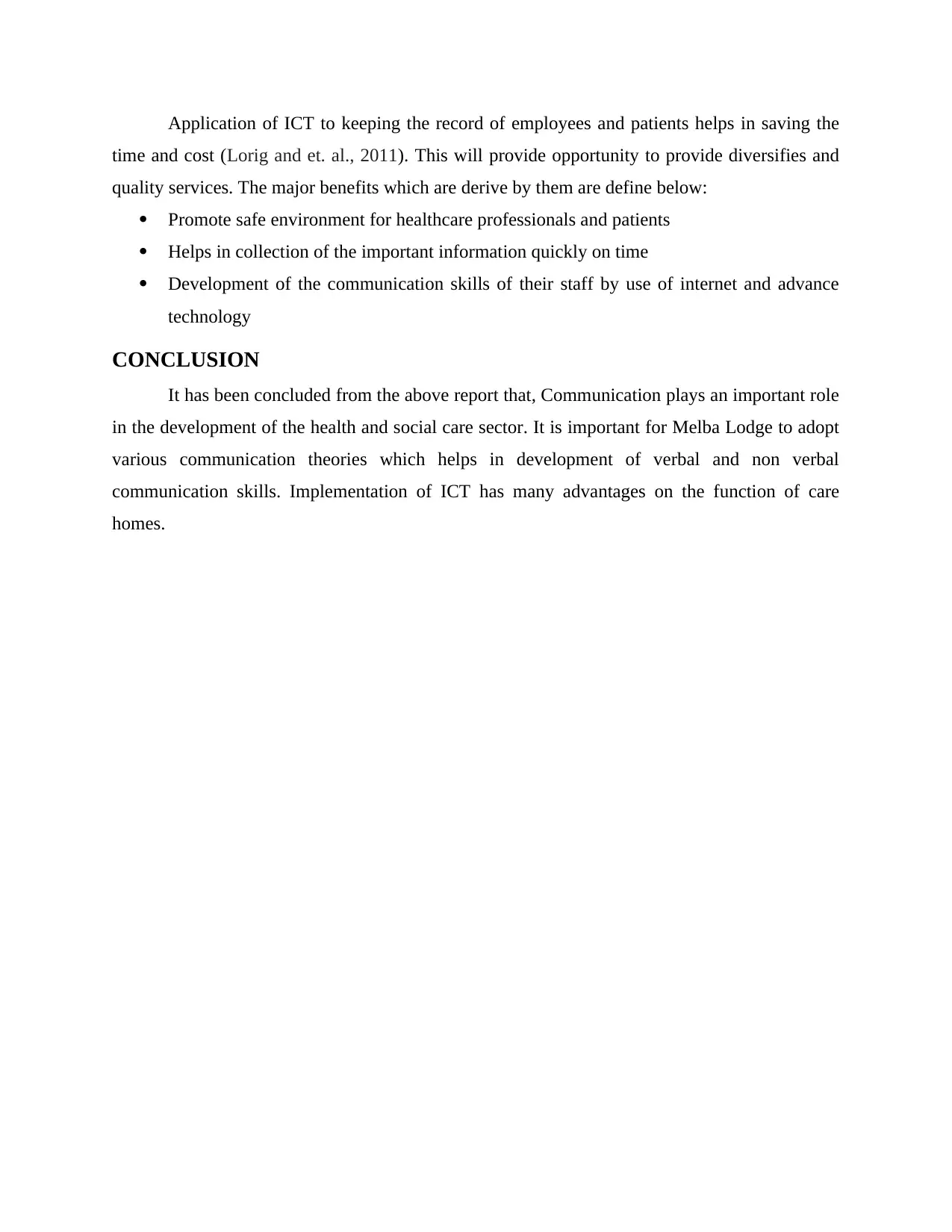
Application of ICT to keeping the record of employees and patients helps in saving the
time and cost (Lorig and et. al., 2011). This will provide opportunity to provide diversifies and
quality services. The major benefits which are derive by them are define below:
Promote safe environment for healthcare professionals and patients
Helps in collection of the important information quickly on time
Development of the communication skills of their staff by use of internet and advance
technology
CONCLUSION
It has been concluded from the above report that, Communication plays an important role
in the development of the health and social care sector. It is important for Melba Lodge to adopt
various communication theories which helps in development of verbal and non verbal
communication skills. Implementation of ICT has many advantages on the function of care
homes.
time and cost (Lorig and et. al., 2011). This will provide opportunity to provide diversifies and
quality services. The major benefits which are derive by them are define below:
Promote safe environment for healthcare professionals and patients
Helps in collection of the important information quickly on time
Development of the communication skills of their staff by use of internet and advance
technology
CONCLUSION
It has been concluded from the above report that, Communication plays an important role
in the development of the health and social care sector. It is important for Melba Lodge to adopt
various communication theories which helps in development of verbal and non verbal
communication skills. Implementation of ICT has many advantages on the function of care
homes.
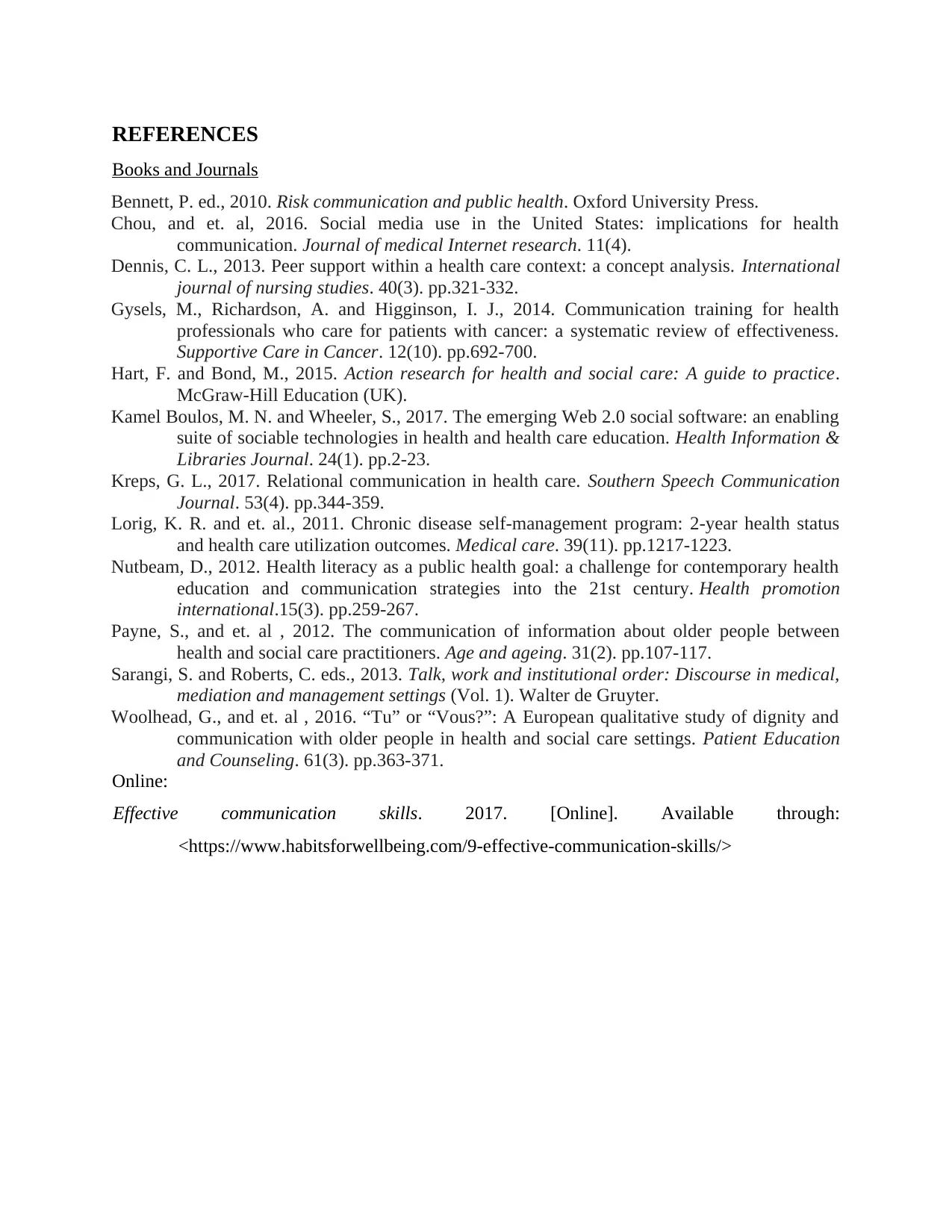
REFERENCES
Books and Journals
Bennett, P. ed., 2010. Risk communication and public health. Oxford University Press.
Chou, and et. al, 2016. Social media use in the United States: implications for health
communication. Journal of medical Internet research. 11(4).
Dennis, C. L., 2013. Peer support within a health care context: a concept analysis. International
journal of nursing studies. 40(3). pp.321-332.
Gysels, M., Richardson, A. and Higginson, I. J., 2014. Communication training for health
professionals who care for patients with cancer: a systematic review of effectiveness.
Supportive Care in Cancer. 12(10). pp.692-700.
Hart, F. and Bond, M., 2015. Action research for health and social care: A guide to practice.
McGraw-Hill Education (UK).
Kamel Boulos, M. N. and Wheeler, S., 2017. The emerging Web 2.0 social software: an enabling
suite of sociable technologies in health and health care education. Health Information &
Libraries Journal. 24(1). pp.2-23.
Kreps, G. L., 2017. Relational communication in health care. Southern Speech Communication
Journal. 53(4). pp.344-359.
Lorig, K. R. and et. al., 2011. Chronic disease self-management program: 2-year health status
and health care utilization outcomes. Medical care. 39(11). pp.1217-1223.
Nutbeam, D., 2012. Health literacy as a public health goal: a challenge for contemporary health
education and communication strategies into the 21st century. Health promotion
international.15(3). pp.259-267.
Payne, S., and et. al , 2012. The communication of information about older people between
health and social care practitioners. Age and ageing. 31(2). pp.107-117.
Sarangi, S. and Roberts, C. eds., 2013. Talk, work and institutional order: Discourse in medical,
mediation and management settings (Vol. 1). Walter de Gruyter.
Woolhead, G., and et. al , 2016. “Tu” or “Vous?”: A European qualitative study of dignity and
communication with older people in health and social care settings. Patient Education
and Counseling. 61(3). pp.363-371.
Online:
Effective communication skills. 2017. [Online]. Available through:
<https://www.habitsforwellbeing.com/9-effective-communication-skills/>
Books and Journals
Bennett, P. ed., 2010. Risk communication and public health. Oxford University Press.
Chou, and et. al, 2016. Social media use in the United States: implications for health
communication. Journal of medical Internet research. 11(4).
Dennis, C. L., 2013. Peer support within a health care context: a concept analysis. International
journal of nursing studies. 40(3). pp.321-332.
Gysels, M., Richardson, A. and Higginson, I. J., 2014. Communication training for health
professionals who care for patients with cancer: a systematic review of effectiveness.
Supportive Care in Cancer. 12(10). pp.692-700.
Hart, F. and Bond, M., 2015. Action research for health and social care: A guide to practice.
McGraw-Hill Education (UK).
Kamel Boulos, M. N. and Wheeler, S., 2017. The emerging Web 2.0 social software: an enabling
suite of sociable technologies in health and health care education. Health Information &
Libraries Journal. 24(1). pp.2-23.
Kreps, G. L., 2017. Relational communication in health care. Southern Speech Communication
Journal. 53(4). pp.344-359.
Lorig, K. R. and et. al., 2011. Chronic disease self-management program: 2-year health status
and health care utilization outcomes. Medical care. 39(11). pp.1217-1223.
Nutbeam, D., 2012. Health literacy as a public health goal: a challenge for contemporary health
education and communication strategies into the 21st century. Health promotion
international.15(3). pp.259-267.
Payne, S., and et. al , 2012. The communication of information about older people between
health and social care practitioners. Age and ageing. 31(2). pp.107-117.
Sarangi, S. and Roberts, C. eds., 2013. Talk, work and institutional order: Discourse in medical,
mediation and management settings (Vol. 1). Walter de Gruyter.
Woolhead, G., and et. al , 2016. “Tu” or “Vous?”: A European qualitative study of dignity and
communication with older people in health and social care settings. Patient Education
and Counseling. 61(3). pp.363-371.
Online:
Effective communication skills. 2017. [Online]. Available through:
<https://www.habitsforwellbeing.com/9-effective-communication-skills/>
⊘ This is a preview!⊘
Do you want full access?
Subscribe today to unlock all pages.

Trusted by 1+ million students worldwide

1 out of 10
Related Documents
Your All-in-One AI-Powered Toolkit for Academic Success.
+13062052269
info@desklib.com
Available 24*7 on WhatsApp / Email
![[object Object]](/_next/static/media/star-bottom.7253800d.svg)
Unlock your academic potential
Copyright © 2020–2025 A2Z Services. All Rights Reserved. Developed and managed by ZUCOL.





